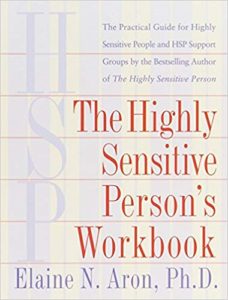 Aron, E. (1999). The Highly Sensitive Person’s Workbook. New York, NY: Broadway Books. ISBN: 978-0-415-80074-7.
Aron, E. (1999). The Highly Sensitive Person’s Workbook. New York, NY: Broadway Books. ISBN: 978-0-415-80074-7.
Available in Paperback.
Paperback. 317 Pages. Includes index.
Reviewed by: J. Parker Morris
Elaine N. Aron speaks to people who need daily alone time to function, who have trouble acting naturally in a loud, crowded, bar, or who experience the world vividly. The first of a series of books on highly sensitive people (HSP’s for short) Aron’s self-help book would be beneficial for anyone who is or has contact with an HSP.
Before digging into the contents of the book, Aron provides a brief ‘true or false’ test to give readers an idea of whether or not they are a highly sensitive person. In subsequent chapters, Aron addresses the HSP directly, explaining what it means to be highly sensitive, how the world appears to HSP’s, and ways to live more fully as an HSP. Using client examples, personal language, and realistic application sections, Aron personalizes this book to make readers feel like they are confiding in a personal friend who truly understands their situation and wants to help.
Generally, I am skeptical of self-help books as overly generalized, unrealistic, and incapable of instilling real change. The Highly Sensitive Person was a breath of fresh air. Her narrative is genuine, realistic, and thoughtful. Aron, a self-proclaimed HSP, provides a clear window into the HSP experience. Although I would not label myself HSP, Aron’s explanation and encouragement in this work was a relief. Her section on social discomfort, for one, provided me with specific methods to self-regulate when in social situations. I will certainly keep my notes on this next time I am out on the town.
Accompanying The Highly Sensitive Person, Elaine Aron also wrote The Highly Sensitive Person’s Workbook. The workbook’s format directly mirrors the original self-help book’s the same ten chapter topics, and she adds an application section for potential discussion groups.
After reading Aron’s advice and tips in The Highly Sensitive Person, I was eager to dive into this workbook. Aron warns readers in the introduction this book delves into uncomfortable and unwanted emotions HSP’s may experience. She stresses the dedication and self-care this book requires of its reader. Aron makes it clear that helping oneself through high sensitivity is not for the light-at-heart (ironically). With my copy of The Highly Sensitive Person next to the workbook, I dove in.
In trying some of the exercises myself, I found this workbook to be more explorative than explanatory. When the first book emphasizes the uniqueness of the HSP and the daily struggles, I expected this workbook to explain and eradicate these struggles. The workbook helped me develop a better grasp of myself, as the exercises required much introspection and self-awareness. However, the workbook did not yield the results I expected from it.
In these two books, Aron is non-accusing, gentle, encouraging, and not demanding. She does not speak as if she knows the ultimate truth in life, and she does not place HSPs above less sensitive people. She is informative without persuasion and allows the reader to take her suggestions for themselves. As clinicians, this book can quickly open the mind to learn about HSPs, to generally understand their experiences, and to offer advice to such clients. The Highly Sensitive Person was an excellent building block for the topic of HSP’s.
The workbook, once again for the HSP directly, this book is not specifically for clinicians. However, her target audience does not take away from the potential value this could have for a therapist treating an HSP. Her exercises promote mindfulness, a strategy from which many people in therapy benefit.







